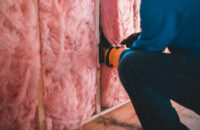How Mold Impacts Insulation
 Mold infestation is dangerous for your family, and the structure of your house and insulation might be the leading cause. Although it might seem counterintuitive, over-insulation has strong chances of harboring a mold disaster. Less radiant heat enters your house. We’ll explain this in detail below. So, make sure you read till the end to avoid over-insulation. But before that, let’s understand how insulation works.
Mold infestation is dangerous for your family, and the structure of your house and insulation might be the leading cause. Although it might seem counterintuitive, over-insulation has strong chances of harboring a mold disaster. Less radiant heat enters your house. We’ll explain this in detail below. So, make sure you read till the end to avoid over-insulation. But before that, let’s understand how insulation works.
How Insulation Works
Insulation is a material placed above the ceiling or the outer walls of a home. Insulation prevents the outside air from entering your home. As a result, the temperature within your house remains constant. Your boiler doesn’t have to overwork in winter because the cold air doesn’t seep inside your house. Likewise, the warm air doesn’t penetrate through thick insulation in summer.
There are a few advantages of insulating your home besides maintaining temperature. These advantages of insulation include.
- The increased market value of your property
- Low energy bills
- Make your home environment friendly.
But everything isn’t bells and whistles with insulation. Because if you go overboard, you might endanger the structural integrity of your house.
Is Overinsulation Possible?
The short answer to this question is, Yes! You can risk mold infestation by over insulating your home. However, it depends on the materials used in the construction of your home. If your property is made from breathable materials like hydraulic lime, over-insulation might lead to the following symptoms.
- Bad indoor air
- Condensation in winter
- Damp floors and walls
- Breathing problems
Mold and Overinsulation
Mold can grow anywhere in your house that sustains its life ingredients such as moisture, mold spores, and a food source. Since mold spores are everywhere on earth and anything cellular can be a food source for mold infestation, the only missing ingredient is moisture.
When you over-insulate your home, the air gets trapped between the breathable material and insulation. It can cause dampness and moisture – creating a breeding ground for mold and mildew. However, if your house is made from cement, you won’t risk mold infestation if you choose proper insulation.
Solution For Over Insulated Homes
If you live in an old property, it’s important to contact local mold removal companies to assess the situation. Working with old properties is challenging because you can’t replace the building material with modern alternatives.
The best way to solve over-insulation in modern homes is to replace the offending material with something breathable. However, if that’s not possible, you can try other means, such as:
- Removing offending insulation
- Window trickle vents
- Install Passive air vents
- Add loft vents
- Add underfloor vents
Can Mold Grow on Attic Insulation?
Mold growth on attic insulation is much less common than growth on the sheathing. Fiberglass insulation isn’t a good food source for mold, and there is no condensation or moisture with insulated walls.
However, in rare cases, mold starts growing on attic insulation. This happens due to over-insulation as less radiant heat enters the attic. For instance, if your attic is over-insulated, its sheathing will be close to the outside temperature because less radiant heat is making its way inside.
As a result, when outside cold air comes in contact with the sheathing in your attic, it creates condensation. This turns into the perfect recipe for mold infestation because they have everything they need.
How to Prevent Mold Infestation on Insulation
We have established that mold infestation is dangerous and can lead to breathing problems and structural damage. You can minimize it by controlling the temperature of your house. Still, over-insulation of walls can favor mold growth rather than prevent it.
Insulating Your Pipes
According to EPA, insulating your pipes can solve this problem. Mold grows when there is moisture and food source. When your water lines are insulated, air doesn’t contact varying temperatures. Thus, there are fewer chances of dampness and moisture. As a result, mold infestation is drastically reduced.
Proper Ventilation
Ventilating your appliances can also reduce the chances of mold infestation. Check your stoves and clothe dryers to see if they add to your home’s humidity levels. If you live in a humid area, try using a dehumidifier around the house to control condensation, which leads to mold infestation.
Improving Duct Filteration
According to the National Association of Insulation, improving duct filtration will help better fight against mold infestation. By purifying the indoor air quality, you decrease the number of mold spores. While it’s impossible to eliminate mold spores in the air completely, reducing their number increases your chances of protecting your home from mold infestation.
911 Restoration Dallas Can Help
If you face mold problems in Dallas, you can reach out to 911 restoration for help. Our lines are 24/7 available for your assistance, and we have a 45 minute response time. Besides mold removal,911 restoration has expertise in fire and smoke damage restoration, water damage restoration, and sanitization services. You can call us by dialing (972) 217-8245. We hope the information above helps you solve mold infestation problems. Good luck!



